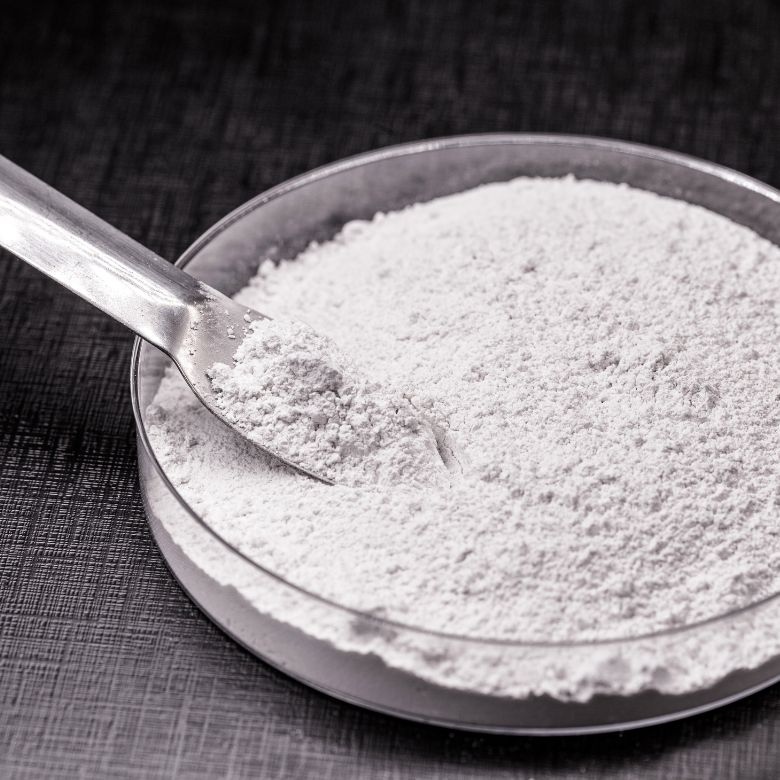Inorganic chemical compounds, known as hydroxides, have many different applications in the industry and in daily life. One of the most well-known hydroxides is white slaked lime. In this article, we will discuss its most important properties and intended use.

What is slaked lime?
The term ‘slaked lime’ stands for calcium hydroxide (Ca(OH)2). It’s a crystalline, basic powder, and solutions of it are also referred to as:
- dead lime,
- hydrated lime,
- calcium dihydroxide,
- whitewash, or
- limewater
What should we know about the structure of slaked lime? Like other compounds classified as hydroxides, slaked lime contains metal cations and hydroxide anions.
Slaked lime: properties
Calcium hydroxide has the form of a solid. It is a caustic, inflammable, white (or white-and-beige) powder having a crystalline structure. It is slightly soluble in water but, at the same time, hygroscopic, which means it absorbs water from the environment. Slaked lime, as a hydroxide, is subject to ionic dissociation, reacts with acids, and causes metal corrosion.
As with any strong base, dead lime is irritating to the human body. The inhalation of its vapours causes breathing difficulties. The Ca(OH)2 damages the skin and eyes. Using Ca(OH)2 powder and solutions that contain it without adequate personal protective equipment is therefore very dangerous and irresponsible.
Production of slaked lime
How can we produce slaked lime? It is enough to slake calcium oxide (burned lime) with water. The chemical reaction can be denoted as follows: CaO + H2O = Ca(OH)2. Combining water and slaked lime is the simplest and most popular method of producing calcium hydroxide. It’s a proven technique used by industrial plants all around the world.
The slaking itself can be performed in two ways. In DIY (do-it-yourself) projects or at construction sites, they use the so-called wet slaking. It is very simple and requires us to combine a larger amount of water with calcium powder (to obtain a solution). Professional production of slaked lime is carried out with a minimal amount of water. The final product in this case is a powder called hydrated lime.
Principal applications of slaked lime
Slaked lime has a lot of applications. It is used by construction chemical producers, for example. Calcium hydroxide is an ingredient in masonry and coating mortars. Sometimes it is also used in agriculture as:
- soil de-acidifier,
- protective formulation that safeguards fruit trees against pests, or
- fertiliser additive.
In power industry, the Ca(OH)2 sorbent is applied in flue gas desulphurisation plants. These are systems and equipment that reduce the amount of poisonous sulphur oxides formed in various production and industrial processes.
The antibacterial, disinfecting and de-acidifying properties of slaked lime are also used at water and wastewater treatment plants. Calcium hydroxide is excellent in neutralising chemical and biological sediments formed by wastewater.
Slaked lime in the form of whitewash is also useful in sugar production. Industrialists add it to beet juice to eliminate contaminants and bacteria.

Medicinal properties of calcium hydroxide
Dentists and endodontists have also recognised the potential provided by calcium hydroxide. It is used as an ingredient, for instance, in cements and dental cavity fillers. Calcium hydroxide is the perfect substance to use when we want to inhibit the growth of bacteria. It is a high-quality component which mitigates the risk of inflammation in the oral cavity. Besides, formulations containing slaked lime support natural regeneration and the healing of holes and incisions made during invasive dental procedures, such as when a tooth is extracted.
The use of slaked lime at home
For hundreds of years, slaked lime has been used by households in various ways. The material used to be applied mainly for whitening walls and ceilings in houses, dugouts, cellars or utility buildings (such as barns, stables, etc.). The lime caused wooden structural members to resist longer to insects and mould. Plus, its bright colour would lighten up interiors and make them look neat.
Gardening enthusiasts apply that cheap and effective formulation to protect their trees and de-acidify their fruit and vegetable beds.
Today the calcium hydroxide is also used at in-house water treatment plants. The plants are connected directly to water mains. Special filters provide ion exchange and reduce the hardness of the water used by households.
Interesting facts about slaked lime
Without a doubt, slaked lime is one of the oldest and most intriguing chemical compounds known to man. Here are some interesting facts about calcium hydroxide:
- Calcium belongs to alkaline earth metals. It can be found in gypsum, marble, and chalk. Given the wide availability of these minerals, lime was used as early as several thousand years before Christ!
- Initially, slaked lime was used to prepare the primitive masonry mortars that gave rise to the development of construction.
- Masonry was mastered by the Romans, who used lime-based mortars on a massive scale.
- In medicine, limewater used to be applied as a drug against acute acid intoxications.
What else should we know about the properties and applications of hydroxides? More interesting information can be found in other posts on our blog. Check them out!
- https://pubchem.ncbi.nlm.nih.gov/compound/Calcium-Hydroxide
- https://bibliotekanauki.pl/articles/137666
- https://gestis.dguv.de/data?name=001150
- https://www.britannica.com/science/calcium-hydroxide
